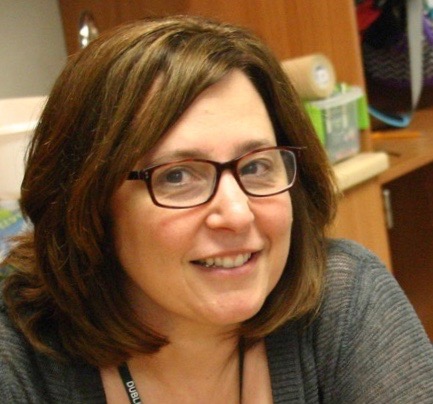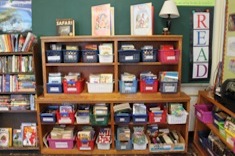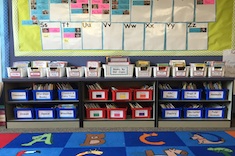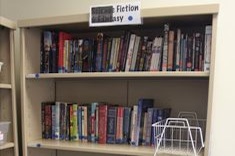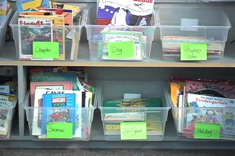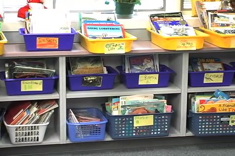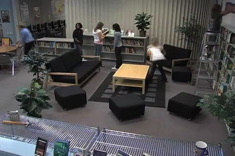I love the end of the school year for many reasons. I actually enjoy closing out the school year and cleaning up a bit, because the process helps me reflect and think ahead to next year.
I am finding that my reflections in closing out the school library are not that much different from when I was packing up and rethinking my classroom library in previous years. The process of cleaning out book tubs, collecting books from students, and weeding out books that are no longer all in one piece invites me to see my text collection with new eyes. It is always fascinating to me that the same books are read over and over by students, whereas others sit on the shelf, either unnoticed or rarely browsed.
I am happy with the general setup of the books. I believe strongly that the way we display texts gives students big messages about reading and book choice. I have noticed a change in the way students talk about books, and I think part of that is because the design invites talk around series and authors. Popular series books are displayed in baskets. Because of this, students have learned if they like one book in a series, they will most likely enjoy others. There is also a lot of display space, which allows me to display many books face-out. If I watch the traffic patterns of the room, I know which books will be most noticed as students pass by.
Questions for Reflection
There are always things I am not happy about when it comes to the organization and display of books. To get at these issues, I ask myself these questions:
- Which titles and series do I have trouble keeping on the shelves? Are there other books similar to the popular ones that I could make more visible?
- Which books seem outdated? Is just the cover outdated, or is the whole book no longer inviting to kids?
- Which new authors, series, or topics should be displayed in a more prominent way?
- How do I make sure to invite different types of reading?
- When I stand at the doorway, which kinds of books seem most important to someone entering the library? Which books are most prominently displayed? Which are difficult to find?
- What does the library setup say about what I value?
- Did I have enough variety for all levels of readers?
- Which series/authors/topics seem a little thin?
- How can I use the display areas to invite kids to stretch as readers and converse with others around books?
- What are new titles that I might want to highlight?
- What are some outstanding books that seem to have remained hidden all year?
- How do I make sure that students find the books they need as they grow as readers?
Reflections from Questions
When I look at the space, I realize that there has been a big emphasis on favorite series, favorite characters, and new books. I wonder how to make other kinds of books more enticing to the students. If I want them to talk about nonfiction and poetry with the same excitement they display when talking about favorite series books, the way I display books can promote those conversations. Much of my thinking over the summer will be about ways to highlight types of books that seem underused.
I purchased many new picture book biographies this year. Our biography section was pretty outdated, and the new picture book biographies are well done. Although the biographies are all displayed in one area, I am not sure that I do much to highlight the books or encourage students to look through them. Next year, I want to help kids become a bit more interested in this genre.
Mary Downing Hahn has become a popular author, and we have only a few of her books. I need to pick up a few more of her books over the summer and add them to the collection.
It seems that you can never have enough nonfiction dog books. I’ll be keeping my eyes out for books about pets that might expand the kinds of reading that kids do on the topic.
Students seem to jump from picture books to Junie B. Jones with no reading in between. How can I highlight more transitional books for younger readers? There are so many excellent books to support these readers as they transition to chapter books, but they aren’t necessarily part of a series. How can I make them more accessible to the kids who need them?
How can I stretch students’ nonfiction reading to include authors such as Steve Jenkins, Nicola Davies, and Seymour Simon? The students seem to love looking at the images in nonfiction texts, but often merely skim and scan. How might I promote books that are written in a way that invites readers to read cover to cover? How will I find space for nonfiction author baskets?
How might I do a better job of sharing some classics? Students seem to be reading more fantasy than ever before. They tend to read the newer fantasies, but I am sure that many of these readers would love the classic ones such as A Wrinkle in Time. Can I somehow connect these books to recent releases, or highlight all fantasy books in a way that encourages reading of both old and new titles?
I also find myself thinking about display space and how to make it more usable for kids. As I clean, I always realize that there are unused wall spaces that could serve as great display areas. If done well, displays can invite thoughtful conversations. So often the kids are lined up near the door or chatting near the cubby areas—these areas are ripe for book displays. Changing displays more often is definitely a goal for me for next year.
I love the quiet time I spend organizing, discarding, and especially, thinking about these questions and issues as I close out the library for another year. My annual reflections will keep me thinking all summer long as I shop for books, read new titles, and ponder possible changes for next year.


